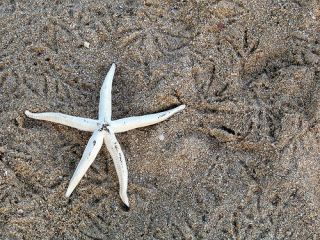Creativity
You may be a starfish and not even know it
What can starfish teach us?
Posted March 24, 2013
Starfish… Go to google and look for images of starfish sometime. When I did, I was astounded and enchanted. I wished I majored in marine biology or at least grown up on a beach. Vivid colors, wildly varying shapes, and many types of textures. And then I started reading about them and became even more captivated.

Jonathan Dale, Starfish Science blog
In school, I remember learning that starfish can regenerate a limb if they lose it. The one in this photo is in the process. But that’s just one aspect of these remarkable creatures. And as I learned more, I began thinking about what their characteristics might teach humans.
Most starfish regenerate a lost limb, indeed. But they also have two stomachs, including one that can be external, which allows the starfish to “eat” something much larger than its normal “mouth” would allow. (Make sense?). That also allows them to be “opportunistic feeders,” eating multiple meals at once.
In addition, starfish are all over the oceans—from the equator to the Arctic, from the ocean’s surface to far below, meaning they adapt to a wide range of environments.
And last, when starfish are on a beach, they move, they make tracks. Quite interesting and visible.

Starfish tracks, Esperales, Phototree
So what’s this have to do with people—and creativity? First, my pitch is always to look for ideas beyond our normal fields and connect interesting odd dots. What could be “odder” than starfish and humans?
But the dots may fit because I think these starfish characteristics would make pretty good ones for humans.
In my own community, like many around the world, we are seeking to sustain strong economic development. Maybe instead of just focusing on bringing in venture capital or reduce taxes, we need to think about the types of people—and their characteristics—that would help. Perhaps we need to become a community of starfish.
Think about it – why not look for and develop people who:
- Can regenerate or reinvent themselves?
- Are opportunistic?
- Can adapt to different environments?
- Can make tracks—or, make a difference?
These are people who can take initiative and follow through, people who can see and then take advantage of opportunities around them, and people who go even further than just seeing opportunities to being able to create them.
The other nice part of this is we can each BE starfish (or try to be) but if we can help one starfish, that starts to build a community of creative, entrepreneurial people who want to make a difference.
Remember the old story about the little boy on the beach, attributed to Loren Eisley? It fits this thinking. As the boy strolls the beach, tossing a starfish into the ocean, a man says, “there are hundreds of starfish on this beach. You can’t save them all.”
“No,” says the boy, “but I can help this one.”
Be a starfish, help a starfish. And build a community of starfish along the way.


